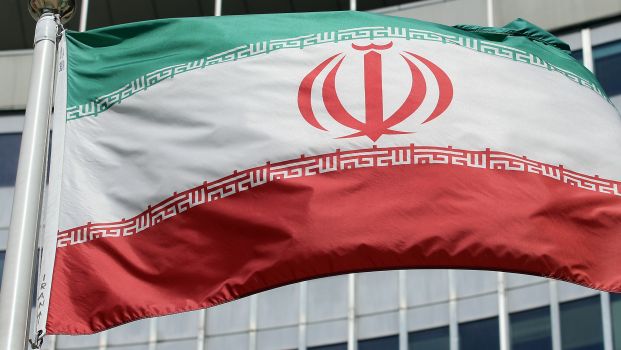
The Iranian flag flies in front of a UN building where closed-door nuclear talks take place at the International Center in Vienna, Austria, on Friday, July 4, 2014. (AP Photo/Ronald Zak)
London, Asharq Al-Awsat—Iran’s Ministry of Intelligence and Security (MOIS) has ordered the country’s security forces to prevent commemorations of the assassination of Islam’s second Caliph, fearing the celebrations may stoke sectarian tensions between Sunnis and Shi’ites, according to a document leaked to the press on Thursday.
A source close to the Iranian government, speaking to Asharq Al-Awsat on condition of anonymity, said: “The current crackdown on anti-Sunni sentiments has become an integral part of Iran’s security doctrine, given the increasing regional instability and in particular the threat of the Islamic State of Iraq and Syria (ISIS) recruiting inside Iranian territory.”
Sunnis make up almost ten percent of the Iranian population of 75 million, and are concentrated in Kurdish areas, the province of Sistan and Baluchistan, and the capital Tehran. ISIS’s recent advances have extended the influence of the group to areas close to Iraq’s border with Iran. The group holds to a radical, chauvinistic ideology and regards Shi’ites as heretics.
The move may also be part of an attempt to reduce regional tensions, which have seen majority-Shi’ite Iran on the opposite side of a number of regional disputes to its Sunni neighbors in the Gulf, such as the conflict in Syria. Despite these differences, the rise of ISIS has presented both sides with a common enemy.
Some radical Shi’ite groups celebrate the death of the second Caliph, Omar, who was assassinated in 644 CE, as part of a religious commemoration known as Eid Al-Zahra, as Omar is blamed in some sources for the death of the Prophet Muhammad’s daughter Fatima Al-Zahra.
In an executive order leaked on Thursday, the MOIS condemned such celebrations as “false, immoral, and separatist.”
The move comes as part of a wider crackdown on religious groups and media outlets within Iran accused of whipping up hatred against Sunnis, in the wake of ISIS’s stunning successes in Iraq and Syria.
In June, MOIS raided the offices of radical Shi’ite satellite TV channels in the city of Qom, and ordered them to close down their operations.
Reports published by semi-official news agencies said the raids were part of government efforts to prevent the spreading of anti-Sunni content on Iran’s airwaves.
According to reports, by the beginning of August up to 12 offices belonging to radical satellite channels were reported to have been closed down for “spreading sectarian sentiments between Shi’ites and Sunnis and defaming Shi’ism.”
Since the establishment of the Safavid Empire in the 15th century CE, Iran has become predominantly populated with Shi’ites, with some Iranian Shi’ites adopting radical beliefs starkly at odds with the mainstream of Sunni Islam.
Such radical beliefs and rituals continued to flourish during the rule of the Qajar dynasty, and even up to the Pahlavi dynasty, which was overthrown in 1979. Under the Islamic Republic, a number of such radical beliefs have been incorporated into government propaganda.
However, the government of President Hassan Rouhani, elected last year, has attempted to distance itself from the more radical religious agenda of his predecessor Mahmoud Ahmadinejad, leading Rouhani to appoint a senior aide for religious and ethnic minorities.

Trackbacks/Pingbacks